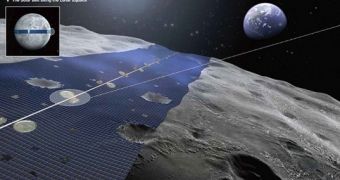Tokyo-based architectural, engineering and general contracting firm Shimizu Corporation has some very big plans for our planet's satellite. Long story short, the company plans to build a monster solar plant on the moon and have it beam green energy to Earth.
Information shared with the public says that, when completed, this moon solar plant would look very much like a belt “hugging” the satellite's equator.
By the looks of it, Shimizu Corporation plans to make this solar panel belt about 6,800 miles (10,943 kilometers) long. The belt's width will average 250 miles (402 kilometers), Inhabitat reports.
Given the size of this proposed moon solar plant, dubbed the Luna Ring, it's no wonder that specialists estimate that its output will be somewhere around 13,000 terawatts.
This green energy would be sent to receiving stations down on Earth, and then made to power households, businesses and the like.
Shimizu Corporation says that, because it will be installed on the moon's surface, the Luna Ring will not be affected by bad weather, and will therefore be much more efficient than the solar plants up and running on Earth. What's more, it will be able to generate power 24/7.
“A shift from economical use of limited resources to the unlimited use of clean energy is the ultimate dream of all mankind. The LUNA RING, our lunar solar power generation concept, translates this dream into reality through ingenious ideas coupled with advanced space technologies,” Shimizu Corporation writes on its website.
Furthermore, “Virtually inexhaustible, nonpolluting solar energy is the ultimate source of green energy that brings prosperity to nature as well as our lives. Shimizu Corporation proposes The Luna Ring for the infinite coexistence of mankind and the Earth.”
The company has not yet released any information concerning how much building the Luna Ring will cost. However, it says that, should things go as planned, construction activities will begin as early as 2035.

 14 DAY TRIAL //
14 DAY TRIAL //